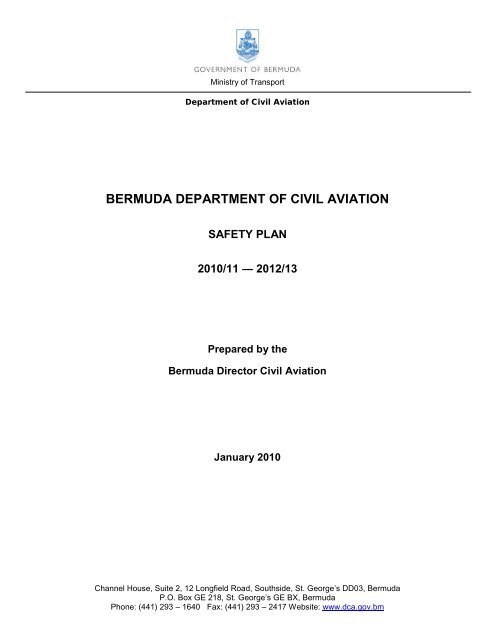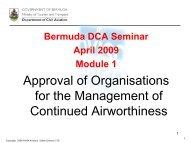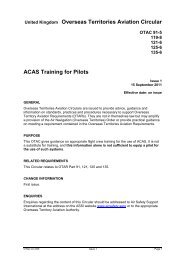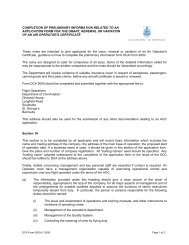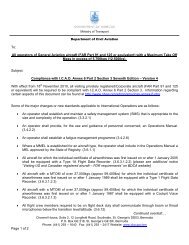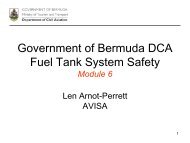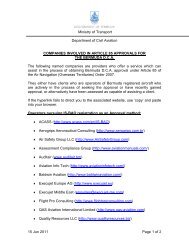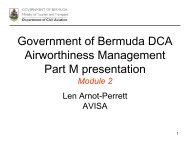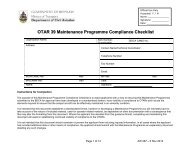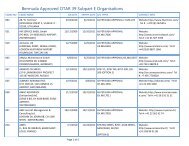BDCA Safety Plan - Bermuda Department of Civil Aviation
BDCA Safety Plan - Bermuda Department of Civil Aviation
BDCA Safety Plan - Bermuda Department of Civil Aviation
You also want an ePaper? Increase the reach of your titles
YUMPU automatically turns print PDFs into web optimized ePapers that Google loves.
Ministry <strong>of</strong> Transport<strong>Department</strong> <strong>of</strong> <strong>Civil</strong> <strong>Aviation</strong>BERMUDA DEPARTMENT OF CIVIL AVIATIONSAFETY PLAN2010/11 ― 2012/13Prepared by the<strong>Bermuda</strong> Director <strong>Civil</strong> <strong>Aviation</strong>January 2010Channel House, Suite 2, 12 Longfield Road, Southside, St. George’s DD03, <strong>Bermuda</strong>P.O. Box GE 218, St. George’s GE BX, <strong>Bermuda</strong>Phone: (441) 293 – 1640 Fax: (441) 293 – 2417 Website: www.dca.gov.bm
<strong>BDCA</strong> SAFETY PLAN2010/11 ― 2012/131. IntroductionThe <strong>Bermuda</strong> <strong>Department</strong> <strong>of</strong> <strong>Civil</strong> <strong>Aviation</strong> (<strong>BDCA</strong>) is pleased to present its first formal three-year<strong>Safety</strong> <strong>Plan</strong>.The <strong>Safety</strong> <strong>Plan</strong> demonstrates the <strong>Department</strong>’s commitment to enhance the safety performance<strong>of</strong> the <strong>Bermuda</strong> civil aviation system. Copies are being provided to the Governor and to theGovernment <strong>of</strong> <strong>Bermuda</strong>, as well as to Air <strong>Safety</strong> Support International (ASSI), signatories <strong>of</strong>83bis agreements and key aviation stakeholders. The <strong>Safety</strong> <strong>Plan</strong> describes the priorities for the<strong>Department</strong> and for the industry over the next three years. Formal reports will be preparedannually to summarise the achievements <strong>of</strong> <strong>BDCA</strong> and the industry.The initiative follows in the steps <strong>of</strong> a recent requirement by the International <strong>Civil</strong> <strong>Aviation</strong>Organisation (ICAO) for each member State to develop and implement a State <strong>Safety</strong>Programme (SSP). A key element <strong>of</strong> the SSP is the State <strong>Safety</strong> <strong>Plan</strong>. The United Kingdompublished its SSP in 2009, and the ASSI, after consultation with the OTAAs, prepared an All-OT<strong>Safety</strong> <strong>Plan</strong>. The <strong>Bermuda</strong> <strong>Department</strong> <strong>of</strong> <strong>Civil</strong> <strong>Aviation</strong> (<strong>BDCA</strong>) and the other OTAAs arerequired to prepare a <strong>Safety</strong> <strong>Plan</strong> that addresses the needs <strong>of</strong> their OT and responds to relevantobjectives contained in the All-OT <strong>Safety</strong> <strong>Plan</strong>.The <strong>BDCA</strong> <strong>Safety</strong> <strong>Plan</strong> enables the <strong>Department</strong> to coordinate its short-and long-term regulatoryprogrammes with the safety planning <strong>of</strong> the air operators and service providers it oversees. In thisway, the <strong>Department</strong>’s <strong>Safety</strong> <strong>Plan</strong> and the industry’s safety goals and objectives ― arequirement <strong>of</strong> their safety management systems ― will lead to systematic and proactivemanagement and measurement <strong>of</strong> safety.2. The <strong>BDCA</strong> <strong>Safety</strong> <strong>Plan</strong> 2010/11 ― 2012/132.1 GeneralThe <strong>BDCA</strong> <strong>Safety</strong> <strong>Plan</strong> focuses on three strategic areas:• Improving the effectiveness and sustainability <strong>of</strong> <strong>BDCA</strong>’s regulatory and oversightprogrammes;• Enhancing the performance <strong>of</strong> safety management systems (SMS) being operated by theaviation industry; and• Enhancing safety culture throughout the <strong>Bermuda</strong> civil aviation system..2.2 Improve the effectiveness <strong>of</strong> the regulatory and oversight programmesIt is <strong>BDCA</strong>’s goal that by March 2013, the <strong>Department</strong> will be fully “fit for purpose”. The proposedre-organisation <strong>of</strong> the <strong>Department</strong> will be complete, and a satellite <strong>of</strong>fice will be in-place, providingsignificant efficiencies to the <strong>of</strong>f-island component <strong>of</strong> <strong>BDCA</strong>’s mandate. The <strong>Department</strong>’sactivities will be fully sustained. Positions will be staffed, with succession planning underway; allprocesses will be fully integrated and documented; and safety and business planning will be riskbased.Day-to-day and long-term decisions will be informed by a rigorous system that enablesrisk-related information to be collected, analysed and applied. The <strong>BDCA</strong> will manage acomprehensive self-assessment process that supplements the evaluations conducted by ASSI. Itwill competently oversee the industry’s proactive management and measurement <strong>of</strong> its safetyperformance, described in 2.3.January 2010 1
<strong>BDCA</strong> SAFETY PLAN2010/11 ― 2012/13This will be the most challenging <strong>of</strong> the three-year goals. Objectives for 2010–11 focus onbuilding the foundation for the reorganised <strong>Department</strong>, and documenting the associatedprocesses. Additionally, attention will be given to advising industry on ways to improve their SMS.The second year (2011–12) will concentrate on finalising and fine-tuning <strong>BDCA</strong> processes; sothat activities during 2012–2013 will see improvements to the delivery <strong>of</strong> the <strong>Department</strong>’sservices and oversight programme.2.3 Enhance the effectiveness <strong>of</strong> the aviation industry’s safety management systemsIt is <strong>BDCA</strong>’s goal that by March 2013, air operators and service providers will operate functioningsafety management systems. <strong>Safety</strong> goals and objectives to improve safety performance will beincorporated into organisations’ business planning processes; and the industry will activelymeasure the results <strong>of</strong> their SMS-related activities. Change – whether operational, technical ororganisational – will, as a matter <strong>of</strong> routine, be guided by the results <strong>of</strong> proactive hazard analyses.Reporting cultures will be steadily improving in two regards: managers will value and employ thereports <strong>of</strong> hazards that have been submitted by staff, clients and customers; and operators andservice providers will increasingly report weaknesses in their safety management, and the actionsthey are taking to make improvements.SMS is an important part <strong>of</strong> <strong>BDCA</strong>’s oversight programme. The <strong>Department</strong> will be particularlychallenged because <strong>of</strong> the geographically dispersed nature <strong>of</strong> the <strong>Bermuda</strong> aviation industry.Objectives for 2010–11 encourage the industry to embrace SMS. Activities for the following yearwill address ways the industry can customise their SMS to suit their safety managementrequirements. During the final year <strong>of</strong> the planning cycle, <strong>BDCA</strong> will cement a redefined andhealthy relationship with its industry, one that leads to effective and coordinated efforts by theindustry to improve its safety performance.2.4 Enhance safety culture throughout the <strong>Bermuda</strong> <strong>Civil</strong> <strong>Aviation</strong> SystemThere is increasing recognition that an SMS is truly effective only when it is driven by a selfsustaining,positive safety culture. SMS and safety culture work synergistically: a functioning SMSdevelops competencies in safety and project management that yield measurable efficiencies andimprovements. These, in turn, inject confidence in the SMS ― amongst the company’s executive,managers and staff ― which in turn breeds trust, and improvements to the company’s safetyculture.For these reasons, it is <strong>BDCA</strong>’s goal that by March 2013, all constituents <strong>of</strong> the <strong>Bermuda</strong> civilaviation industry will actively and willingly collect, analyse, use and share safety-relatedinformation. The lateral and vertical movement <strong>of</strong> information will cross sectors, and aid <strong>BDCA</strong>,ASSI, the <strong>Bermuda</strong> Government and the aviation industry to improve safety performance. Theindustry and its stakeholders will be well on their way to developing a true, learning culture – onein which feedback will be wholeheartedly valued; and safety management measured as part <strong>of</strong>their performance objectives.3. <strong>Safety</strong> Objectives for 2010–11Objectives one through three for 2010–2011 address improvements to <strong>BDCA</strong> regulatory andoversight programmes.3.1 The <strong>BDCA</strong> has not conducted explicit safety planning in the past. There is need to ensure thatthe planning and reporting process is purposeful and sustained, and that expectations arecommunicated and well understood by the stakeholders. For this reason, the followingobjective has been adopted.January 2010 2
<strong>BDCA</strong> SAFETY PLAN2010/11 ― 2012/132010–11 Objective No. 1: <strong>BDCA</strong> will implement sustainable safety planning and reporting.The objective will be achieved by:• Developing internal policy and processes for safety planning, and for the periodicreview and reporting <strong>of</strong> achievements;• Facilitating and promoting safety planning by operators and service providers; and• Implementing a robust system, internal to the <strong>BDCA</strong>, to collect, analyse and reportinformation regarding safety or quality deficiencies in the fulfillment <strong>of</strong> the<strong>Department</strong>’s mandate.3.2 Independent studies, assessments and audits conducted in the last two years have identifieddeficiencies in <strong>BDCA</strong>’s capacity to fulfill its mandate. In late-2009, the report <strong>of</strong> a Strategic<strong>Plan</strong>ning Review proposed a complete reorganisation <strong>of</strong> the <strong>Department</strong>. The Government <strong>of</strong><strong>Bermuda</strong> is considering the recommendations. If they are accepted, there will be need tosystematically transition to the new organisation while continuing to provide regulatoryservices and safety oversight. Therefore, the following objective has been adopted for 2010 –2011, recognising that the resulting activities will extend across the subsequent two years.2010–11 Objective No. 2: <strong>BDCA</strong> will implement recommendations <strong>of</strong> the Strategic <strong>Plan</strong>ningReview in accordance with government direction.The objective will be achieved by:• Implementing a plan to reorganize the department;• Implementing a plan to manage a Satellite Office outside <strong>of</strong> <strong>Bermuda</strong>; and• Implementing a plan to enable <strong>Department</strong>al activities to be sustained during thetransition to the new organisation.3.3 Many studies mentioned in 3.2 also noted deficiencies in the <strong>Department</strong>’s documentation.Although immediate action is required, the activities must take account <strong>of</strong> the many changesthat will occur after the reorganisation <strong>of</strong> the <strong>Department</strong>. Consequently, the followingobjective has been adopted.2010–11 Objective No. 3: <strong>BDCA</strong> will develop the documents, and a document managementsystem, for the short- and long-term.The objective will be achieved by:• Updating and creating essential documents to manage the <strong>Department</strong> until the reorganisationis complete; and• Developing a plan that, in the long-term documents the management <strong>of</strong> the<strong>Department</strong>. It will take several years to implement this plan.Objectives four through six for 2010–2011 focus on the operation <strong>of</strong> SMS by the aviation industry.3.4 The <strong>BDCA</strong> <strong>Safety</strong> <strong>Plan</strong> has the potential to aid the industry to set safety goals and objectives.With time, the link between State <strong>Safety</strong> Programmes, <strong>Safety</strong> <strong>Plan</strong>s and SMS goals andobjectives will coordinate initiatives to improve safety throughout the aviation industry. In theJanuary 2010 3
<strong>BDCA</strong> SAFETY PLAN2010/11 ― 2012/13interim, the foundation for safety planning and measurement needs to be formed. Therefore,the following objective for the next year has been adopted.2010–11 Objective No. 4: <strong>BDCA</strong> will encourage industry, as part <strong>of</strong> their SMS, to selectobjectives from the <strong>BDCA</strong> <strong>Safety</strong> <strong>Plan</strong>, as well as objectives that address specificrequirements <strong>of</strong> their organisation. This objective will be achieved by:• Communicating the department’s obligations under the UK State <strong>Safety</strong> Programme,and communicating the contents <strong>of</strong> the <strong>BDCA</strong> <strong>Safety</strong> <strong>Plan</strong>; and• Periodically exchanging information regarding the achievements <strong>of</strong> <strong>BDCA</strong>’s andindustry’s objectives.3.5 SMS is relatively new to the aviation industry. No department-wide policy currently exists thatprovides direction in evaluating the SMS <strong>of</strong> an operator or service provider. For this reason,the following objective has been adopted for 2010–2011.2010–11 Objective No. 5: <strong>BDCA</strong> will promulgate policy for determining the acceptability <strong>of</strong> thesafety management system submitted by an operator or service provider, and for the ongoingevaluation <strong>of</strong> SMS.Inspectors will require different tools and skill sets to evaluate SMS. Consequently, thefollowing objective has been adopted.2010–11 Objective No. 6: <strong>BDCA</strong> will adopt and employ practical SMS evaluation tools.This objective will be achieved by:• Developing an evaluation protocol and preparing the necessary procedures• Training <strong>BDCA</strong> staff;• Communicating with the industry about the SMS evaluation protocol(s); and• Evaluating at least one air operator and one service provider.Objectives seven and eight for 2010–2011 focus on enhancing safety culture throughout the<strong>Bermuda</strong> <strong>Civil</strong> <strong>Aviation</strong> System.3.7 <strong>Department</strong> staff have diverse pr<strong>of</strong>essional backgrounds and responsibilities. The revisions toregulatory programmes required by ICAO provide an opportunity for the <strong>BDCA</strong> to enhance itsalready strong safety culture.2010–11 Objective No.7: <strong>BDCA</strong> will enhance safety culture within the department.This objective will be achieved by;• Involving staff from all branches <strong>of</strong> <strong>BDCA</strong> in safety planning and reportingprocesses, and by employing cross-department teams to coordinate, implementand report progress on activities related to the <strong>Department</strong>’s objectives;• Attending ASSI-sponsored and other courses on safety culture; and• Promoting a positive safety culture in the <strong>Department</strong>’s day-to-day activities.1 ;1 A number <strong>of</strong> methods exist, including two developed by ASSI.January 2010 4
<strong>BDCA</strong> SAFETY PLAN2010/11 ― 2012/133.8 <strong>Safety</strong> management and safety culture benefit from the free-flow <strong>of</strong> safety-related information.Therefore, the following objective has been adopted.2010–11 Objective No 8: <strong>BDCA</strong> will set the example by sharing safety-related informationthroughout the <strong>Bermuda</strong> <strong>Civil</strong> <strong>Aviation</strong> System. The objective will be met by:• reporting achievements related to the <strong>Safety</strong> <strong>Plan</strong> to key stakeholders, includingASSI, the Governor, the <strong>Bermuda</strong> Government, governments with which <strong>Bermuda</strong>has an Article 83bis arrangement, and operators and service providers;• providing quarterly “safety updates” to industry representatives and otherstakeholders; and• encouraging industry to share information they obtain and analyse as part <strong>of</strong> theirSMS.4. <strong>Safety</strong> Objectives under consideration for 2011–13The following annual objectives are being considered for the two remaining years in the planningcycle. The objectives for 20011 – 12 will be finalised by December 2010 and published early in2011.Possible objectives for 2011 – 2012• <strong>BDCA</strong> will systematically provide feedback to industry regarding the performance <strong>of</strong> theirSMS by:• Implementing an audit/evaluation schedule <strong>of</strong> industry’s SMS;• Analysing the results <strong>of</strong> SMS evaluations at a systems level so the <strong>BDCA</strong> can alignits priorities to areas <strong>of</strong> higher risk; and• Providing information regarding system safety deficiencies to industry and the ASSI,as applicable.• <strong>BDCA</strong> will encourage industry to use self-assessment tools, by, among other means,providing guidance in SMS self-assessment;• <strong>BDCA</strong> is considering hosting a safety event, the objective <strong>of</strong> which will be to gatherindustry representatives together to focus on a specific safety-related issue. The eventmay be a ‘theme-based’ seminar (e.g. on SMS, safety measurement, safety planning orsafety culture), and feature guest speakers or panels; or it may be a ‘regulatory update’ toshare information about ICAO, ASSI, or <strong>BDCA</strong> initiatives; or it may focus on some othertopic that spawns effective dialogue on safety 2 .• <strong>BDCA</strong> will incorporate measures <strong>of</strong> safety culture into the department’s SMS evaluationtechniques.2 <strong>BDCA</strong> currently conducts such sessions to target specific sectors <strong>of</strong> the aviation industry (e.g. sessions held in Moscowto discuss regulatory initiatives with Russian operators and maintenance companies.January 2010 5


